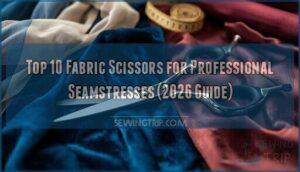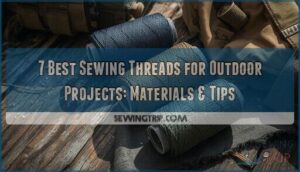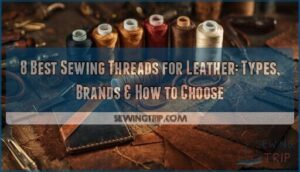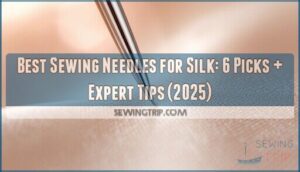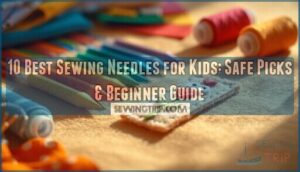This site is supported by our readers. We may earn a commission, at no cost to you, if you purchase through links.
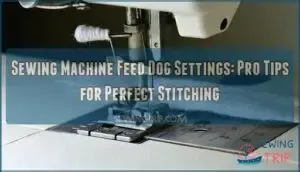
You’ll find the adjustment dial near your needle plate—turn clockwise to raise the feed dogs, counterclockwise to lower them.
Heavy fabrics like denim need higher settings for proper grip, while delicate silks require lower positions to prevent snagging, and cotton sits comfortably in the middle range.
Don’t wing it—always test on scraps first, because your fabric will tell you if something’s off through puckering, skipped stitches, or uneven feeding.
Master these basics and you’ll discover specific techniques for different materials.
Table Of Contents
Key Takeaways
- You’ll get professional results by adjusting feed dog height based on fabric weight – raise them clockwise for heavy materials like denim, lower them counterclockwise for delicate silks, and keep cotton in the middle range.
- Always test your settings on fabric scraps before starting your actual project – your fabric will show you if something’s wrong through puckering, skipped stitches, or uneven feeding.
- Clean and maintain your feed dogs regularly to prevent performance issues – use a small brush to remove lint buildup from the teeth grooves every few sewing sessions and oil the mechanism monthly.
- Standard feed dog height sits at 1.2mm above the needle plate – this factory setting works for most cotton and polyester fabrics, but you’ll need to customize based on your specific material and project needs.
Feed Dog Basics
Your sewing machine’s feed dogs are the small, toothed metal bars beneath the needle plate that grip and move fabric through the machine with each stitch.
Understanding how these essential components work is vital for achieving consistent, professional-quality seams across different fabric types.
Feed Dog Function
Feed dogs grip fabric with metal teeth, moving in discrete steps to pull material through your machine.
These toothed bars prevent slipping by maintaining uniform movement during stitching.
Proper feed dog height guarantees consistent fabric feeding – too high damages delicate materials, too low creates uneven stitches.
Adjusting feed dogs optimizes stitch consistency across different fabric weights and textures.
Feed Dog Purpose
Beyond simply moving material through your machine, feed dogs serve specific purposes that directly impact your sewing success.
These metal teeth work as your fabric’s guidance system, guaranteeing each stitch lands exactly where it should. Understanding their role helps you troubleshoot issues and achieve professional results.
- Fabric Advancement: Feed dogs grip and pull material forward in precise increments, creating consistent spacing between stitches
- Stitch Consistency: They maintain uniform stitch length by moving fabric the same distance with each needle penetration
- Preventing Slippage: The toothed surface provides material grip that stops fabric from shifting during stitching
- Uniform Seams: Coordinated movement with the presser foot ensures straight, even seam lines
- Feed Dog Height regulation allows you to adjust material grip strength for different fabric weights and types
To maintain peak performance, remember regular feed dog cleaning is essential.
Importance of Feed Dogs
Three critical factors make feed dogs indispensable for quality sewing: they guarantee stitch consistency by moving fabric at precise intervals, maintain fabric control during stitching, and prevent fabric slippage that ruins seam alignment.
| Feed Dog Function | Impact on Sewing | Result Without Proper Function |
|---|---|---|
| Uniform Feeding | Even stitch spacing | Irregular, unprofessional seams |
| Fabric Control | Smooth material movement | Bunching and puckering issues |
| Preventing Slippage | Stable fabric positioning | Misaligned pattern pieces |
Your sewing machine’s feed dog settings directly influence seam quality and fabric movement precision, which is crucial for achieving professional-looking results with smooth material movement.
Feed Dog Adjustment
When your sewing machine starts producing uneven stitches or puckered seams, it’s usually your feed dogs crying out for attention.
Getting these metal grippers properly adjusted transforms frustrating fabric fights into smooth, professional results every time, making it a key step to achieve professional results.
Signs of Needed Adjustment
Your machine’s behavior tells the story when feed dogs need attention.
Skipped stitches and loose stitches signal feed dogs sitting too low, failing to grip fabric properly.
Fabric puckering indicates they’re positioned too high, creating excessive tension.
Uneven feeding and tension problems reveal misaligned feed dogs struggling with consistent fabric movement, making adjusting feed dogs essential for smooth operation.
Adjusting Feed Dog Height
Recognizing when your feed dogs need attention, you’ll need to make precise height adjustments.
Remove the needle plate and locate the adjustment screw beneath. Here’s your step-by-step approach:
- Turn the adjustment screw clockwise to raise feed dogs for better fabric grip
- Rotate counter-clockwise to lower them for delicate materials
- Test stitch quality on scrap fabric after each small increment
- Secure the locking mechanism once you’ve achieved perfect height
Standard height settings range from 0.5mm for lightweight fabrics to 1.2mm for heavy materials, guaranteeing perfect stitch quality.
Proper function guarantees consistent stitch length.
Adjusting Feed Dog Angle
Fine-tuning your feed dog angle transforms fabric handling from frustrating to flawless.
Loosen the setscrew adjustments beneath your needle plate, then tilt the mechanism slightly. This alignment technique prevents fabric rubbing and guarantees proper needle clearance during stitching cycles.
| Fabric Type | Recommended Angle |
|---|---|
| Delicate silks | Slight backward tilt |
| Heavy denim | Level position |
| Stretchy knits | Forward angle |
| Slippery satins | Side tilt (operator side up) |
| Multi-layer quilts | Aggressive forward position |
The correct alignment technique is crucial for preventing fabric rubbing and ensuring proper needle clearance. By following these steps and using the recommended angles, you can achieve flawless fabric handling.
Feed Dog Settings
Getting your feed dog settings right can make the difference between professional-looking seams and frustrating sewing sessions.
You’ll need to adjust these settings based on your fabric type and project requirements to achieve consistent, even stitches every time.
Standard Feed Dog Settings
Your sewing machine’s default position sits at factory height—typically 1.2mm above the needle plate.
This standard setting works perfectly for most fabric types and stitch length requirements. You’ll find these feed dog settings handle cotton, polyester, and medium-weight materials without adjusting pressure settings.
Keep your sewing machine settings at this baseline for consistent fabric feeding across everyday projects, ensuring that the feed dog settings handle materials effectively.
Custom Feed Dog Settings
Custom feed dog adjustments transform your machine into a precision instrument for challenging projects.
Professional sewists know that one-size-fits-all settings rarely deliver perfect results when working with specialty fabrics or advanced techniques.
- Height customization – Lower feed dogs for delicate silks to prevent snagging, raise them for leather to guarantee positive fabric movement control
- Angle fine-tuning – Adjust left-to-right positioning to eliminate metal contact with needle plate during creative stitching applications
- Differential settings – Independent front/rear feed dog speeds prevent stretching in knits while maintaining proper fabric feeding for garment construction
When sewing delicate materials, consider fabric preparation techniques to avoid damaging the fabric.
Master these sewing machine settings and you’ll handle everything from quilting techniques to specialty feet applications with confidence.
Feed Dog Settings for Thick Fabrics
When thick fabric gives your machine trouble, adjusting feed dogs becomes your lifeline.
When your machine struggles with heavy materials, raised feed dogs become your sewing superpower.
Raise feed dog height slightly above standard position to grip dense materials like denim and canvas effectively. Increase stitch length to 3.0-4.0mm, allowing feed dogs to move heavy layers without strain or skipped stitches.
| Fabric Type | Feed Dog Height Setting |
|---|---|
| Denim Settings | 1.3-1.5mm above plate |
| Canvas Adjustment | 1.4-1.6mm above plate |
| Leather Feeding | 1.2-1.4mm above plate |
| Vinyl Control | 1.3-1.5mm above plate |
| Upholstery Handling | 1.4-1.7mm above plate |
Feed Dog Settings for Delicate Fabrics
When working with delicate fabrics, lower your feed dog height to reduce fabric snagging risks.
These materials demand precise needle choice and reduced presser foot pressure for smooth fabric feeding.
- Adjust feed dog height – Lower settings prevent marking on silk and chiffon
- Reduce stitch length – Shorter stitches create cleaner seams without stretching
- Balance tension carefully – Fine-tune both upper and bobbin thread tension
- Use stabilizers – Place tissue paper between fabric and feed dogs for protection
Feed Dog Maintenance
Proper feed dog maintenance keeps your sewing machine running smoothly and prevents costly repairs down the line.
You’ll need to clean, oil, and inspect these essential components regularly to guarantee consistent fabric feeding and professional-quality stitches.
Cleaning Feed Dog Teeth
Regular feed dog cleaning prevents performance headaches.
Use a tiny brush to remove lint buildup from teeth grooves every few sewing sessions.
Compressed air blasts away stubborn debris effectively.
For sticky residue, apply minimal solvent on a cotton swab.
A proper tool selection aids in this process.
Clean lint removal keeps your machine humming smoothly and prevents feed dog maintenance issues from derailing projects, which is a key part of regular maintenance.
Oiling Feed Dog Mechanism
Beyond the needle plate lies your machine’s lifeline – proper feed dog oiling guarantees smooth operation and prevents costly repairs. Use lightweight sewing machine oil sparingly to maintain peak performance.
To find the right product, consider buying sewing machine oil specifically designed for this purpose.
- Oil type: Apply only lightweight sewing machine oil designed for precision mechanisms
- Oiling frequency: Oil every 8-10 hours of use or monthly for regular sewers
- Access points: Target pivot points, joints, and moving parts beneath the needle plate
- Preventing over-oiling: Use single drops – excess oil attracts lint and causes buildup
- Post-oiling check: Run test stitches to verify smooth feed dog movement and operation
Inspecting Feed Dog Teeth
After keeping your sewing machine feed dog mechanism properly lubricated, you’ll want to examine the feed dog teeth for damage assessment.
Look for bent, chipped, or worn tooth alignment that affects fabric feeding. Check wear patterns on each tooth – they should appear uniform.
Use proper cleaning methods to remove lint before inspection. If you notice significant damage or uneven wear patterns, it’s replacement timing.
Regular feed dog maintenance prevents costly sewing machine feed dog repairs and guarantees consistent feed dog adjustment performance.
Feed Dog Troubleshooting
Even experienced sewers encounter feed dog problems that can derail their projects faster than you can say "thread jam."
When your stitches start skipping, fabric bunches up, or seams look more crooked than a politician’s promise, it’s time to troubleshoot your feed dogs systematically.
Common Feed Dog Problems
Even well-maintained feed dogs can develop problems that disrupt your stitching rhythm.
Skipped stitches often signal timing issues between feed dogs and needle synchronization.
Uneven feeding creates wavy seams when feed dog teeth wear down or lose their grip.
Fabric puckering happens when bent teeth catch material incorrectly, while alignment issues cause the fabric to veer off course during sewing, leading to problems with feed dog teeth.
Resolving Feed Dog Issues
When skipped stitches or fabric puckering appear, start with feed dog adjustment.
Lower feed dogs slightly for delicate materials experiencing uneven feeding.
Raise them for heavy fabrics showing tension problems.
Check feed alignment by observing fabric movement—jerky motion indicates misaligned feed dogs.
Clean lint buildup around teeth, then test-stitch.
If adjusting feed dogs doesn’t resolve fabric feeding issues, examine needle condition and thread tension settings.
Preventing Feed Dog Damage
Prevention beats reactive sewing machine troubleshooting every time.
Simple protective measures keep your feed dogs functioning smoothly for years:
- Needle Plate Fit – Check alignment monthly to prevent grinding damage
- Fabric Thickness Control – Switch feed dog sets when changing material weights
- Proper Threading – Wrong thread tension strains feed dog mechanisms
Practice gentle cleaning after heavy projects and store your machine covered.
Regular feed dog adjustment prevents costly feed dog repair or feed dog replacement down the road.
Feed Dog Operation
Understanding how your feed dogs operate transforms your sewing from frustrating guesswork into predictable, professional results.
You’ll control fabric movement precisely by mastering the raising, lowering, and timing mechanisms that work behind every perfect stitch, which will allow you to achieve professional results.
Raising and Lowering Feed Dogs
Mastering the drop feed mechanism gives you complete control over fabric manipulation.
Your machine’s feed dog position switch, typically located near the base, lets you raise feed dogs for standard sewing or lower them for specialized techniques.
| Technique | Feed Dog Position | Purpose | Fabric Control | Key Benefit |
|---|---|---|---|---|
| Free-motion Sewing | Lowered/Dropped | Complete manual control | User-directed movement | Creative freedom |
| Button Sewing | Lowered/Dropped | Prevents fabric advancement | Stationary stitching | Precise placement |
| Embroidery Techniques | Lowered/Dropped | Manual fabric guidance | Artistic positioning | Design accuracy |
| Quilting Methods | Raised/Standard | Consistent fabric feeding | Even stitch intervals | Professional results |
| Standard Seaming | Raised/Standard | Automatic fabric transport | Steady progression | Uniform stitches |
The feed dog position switch is crucial for achieving the desired outcome in various sewing techniques, including free-motion sewing, button sewing, embroidery techniques, quilting methods, and standard seaming.
Feed Dog Movement Patterns
Your machine’s feed dogs follow a Four-Motion Sequence that’s like a well-choreographed dance. This Elliptical Movement creates the magic behind consistent stitching through Synchronized Motion.
Here’s how your feed dog motion works:
- Up movement – Feed dogs rise through the needle plate for Fabric Grip
- Back movement – Dogs pull fabric toward you during stitch formation
- Down movement – Dogs drop below plate to release fabric
- Forward movement – Dogs return to starting feed dog position
This Drop Feed system guarantees your fabric moves exactly one stitch length per cycle, maintaining perfect feed dog height and feed dog angle throughout the process. You may need a sewing machine feed dog adjustment to resolve uneven stitches.
Feed Dog Synchronization
Perfect synchronization between your needle timing, presser foot, and bobbin coordination creates flawless stitch formation.
When these three components work together, you’ll achieve superior fabric control through proper feed dog adjustment and positioning.
| Component | Timing Requirement | Impact on Stitching |
|---|---|---|
| Needle Timing | Precise up/down coordination | Prevents thread breakage |
| Presser Foot | Lifts when feed dogs advance | Maintains fabric tension |
| Bobbin Coordination | Thread catches at needle’s lowest point | Creates balanced lock stitch |
Feed dog height and alignment directly affect this delicate dance—adjusting feed dogs guarantees they rise exactly when the presser foot lifts, allowing smooth fabric movement without bunching or skipping stitches, which is crucial for proper feed dog adjustment and superior fabric control.
This synchronization is key to achieving flawless stitch formation and balanced lock stitch, which are essential for professional-looking results, and understanding the role of feed dog adjustment is vital for success.
Feed Dog Types
Your sewing machine likely comes with multiple feed dog types designed for different fabric weights and sewing techniques.
Understanding which feed dogs to use guarantees smooth fabric feeding and prevents damage to your materials.
Standard Feed Dogs
Standard feed dogs work at ideal height settings around 1.2mm above the needle plate, providing reliable fabric grip for basic operation.
Your sewing machine’s default settings handle most cotton and polyester fabrics effectively. These metal teeth create consistent stitch intervals through their four-motion sequence.
When adjusting feed dogs, start with factory specifications before customizing feed dog height for your specific project needs. You can find replacement feed dogs online if needed, which may require adjusting the feed dog height for optimal performance, considering the default settings.
Heavy-Duty Feed Dogs
Heavy duty feed dogs handle thick materials like denim, canvas, leather, vinyl, and upholstery with reinforced steel construction and deeper teeth profiles.
These robust sewing machine feed dogs provide stronger fabric feed through multiple layers, preventing stitch skipping common with standard models.
Proper feed dog settings accommodate materials up to 1cm thick, delivering consistent performance where regular feed dogs struggle.
Regular maintenance prevents smooth operation issues to ensure proper feed dog function.
Fine Feed Dogs
While heavy-duty feed dogs power through thick materials, fine feed dogs handle delicate fabrics like silk and lace with gentle precision.
Their shallow, closely-spaced teeth prevent snags and puckering on lightweight materials.
Proper feed dog height adjustment guarantees microfiber control without damaging fragile threads.
When your sewing machine feed struggles with uneven fabric feed on delicates, switching to fine feed dogs transforms your silk settings from frustrating to flawless.
Feed Dog Optimization
You’ll achieve professional-quality stitching when you master the three key areas of feed dog optimization: height, tension, and alignment.
These adjustments work together to guarantee your fabric moves smoothly and consistently, eliminating common issues like puckering, skipped stitches, and uneven seams.
Optimizing Feed Dog Height
Fabric grip determines your stitching success—set feed dog height at 1.2mm above the needle plate for ideal performance.
Too high damages delicate materials; too low creates uneven fabric feed and poor stitch quality.
Adjust based on material thickness: raise slightly for denim, lower for silk.
Always perform a visual check after feed dog adjustment, ensuring teeth barely protrude through plate slots for consistent sewing machine feed across various fabrics, which affects the overall fabric grip.
Optimizing Feed Dog Tension
Tension balances the delicate dance between fabric grip and gentle handling. Getting this right transforms your sewing machine feed from unpredictable to precise, guaranteeing every stitch maintains consistent quality.
Feed dogs ensure alignment for smooth and efficient sewing.
- Test on scraps first – Different fabrics need different tension settings for ideal fabric feeding
- Watch for slippage signs – Inconsistent stitch length indicates insufficient feed dog adjustment
- Address puckering immediately – Excessive tension causes fabric distortion and poor seam quality
- Fine-tune incrementally – Small tension troubleshooting adjustments prevent overcorrection issues
Optimizing Feed Dog Alignment
Why settle for crooked seams when proper feed dog alignment guarantees professional results?
Check needle plate clearance first—feed dogs should sit flush without rubbing against slots.
Adjust horizontally using your machine’s alignment screws to prevent skewing and maintain stitch line straightness.
Test fabric feed balance with scrap material, guaranteeing consistent seam width across different weights, which helps in achieving complete control over your sewing machine feed system, and proper feed dog adjustment eliminates uneven fabric feed.
Frequently Asked Questions (FAQs)
How to adjust feed dogs on a sewing machine?
Nearly 80% of sewers struggle with uneven stitches due to improper feed dog height.
Remove your needle plate, locate the adjustment screw, and turn clockwise to raise or counter-clockwise to lower.
Test on scrap fabric after small adjustments until you achieve smooth, consistent fabric feeding.
Should feed dogs be up or down when sewing?
Keep your feed dogs up for standard sewing—they’ll grip and move fabric smoothly through the machine.
Lower them only for free-motion quilting, embroidery, or button sewing where you’ll guide fabric manually.
What is the feed dog height on a sewing machine?
Imagine this: your machine’s feed dogs sit approximately 2mm above the needle plate when raised—that perfect sweet spot where they’ll grip your fabric securely.
Without causing damage or puckering during stitching, this positioning is crucial for achieving professional results.
Can feed dogs be replaced with different types?
Yes, you can replace feed dogs with different types designed for specific fabrics and techniques.
Heavy-duty feed dogs work better for thick materials like denim, while fine feed dogs suit delicate fabrics and prevent damage.
What tools are needed for feed dog adjustment?
You’ll need a small screwdriver (typically Phillips head), needle-nose pliers for gripping, and a small brush for cleaning lint.
Some machines require specific hex keys or adjustment tools included with your manual.
How often should feed dogs be professionally serviced?
Like a well-oiled machine that hums along smoothly, your feed dogs should receive professional servicing annually with moderate use, or every six months if you’re sewing daily through thick fabrics.
Are feed dog covers or guards available?
Feed dog covers aren’t standard accessories, but some machines include throat plate guards or specialized needle plates that partially cover feed dogs.
You can find aftermarket guards for specific models online, though they’re primarily designed for decorative stitching or embroidery work.
Which stitch types require lowered feed dogs?
When the rubber meets the road, you’ll need lowered feed dogs for free-motion quilting, embroidery, darning, button sewing, and appliqué work. These techniques require unrestricted fabric movement control.
Conclusion
Perfect sewing machine feed dog settings aren’t just mechanical adjustments—they’re your gateway to professional-quality results that’ll transform every project you touch.
You’ve learned to read your fabric’s needs, adjust height and angle precisely, and troubleshoot common issues before they ruin your work.
Remember that different materials demand specific approaches, from heavy denim requiring higher settings to delicate silks needing gentler positioning.
Test every adjustment on scraps first, maintain your feed dogs regularly, and trust the feedback your fabric provides through stitch quality and movement patterns.













